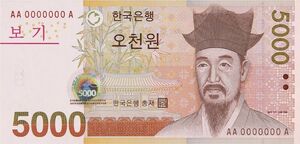m (Yul-Gok diagram) Tag: Visual edit |
(A naked woman's virgina and her big big boobs showing in real life) Tag: Visual edit |
||
| Line 1: | Line 1: | ||
[[File:5000_won_serieV_obverse.jpeg|thumb|right|300px|Yi I on the currently circulating 5,000 won note]] |
[[File:5000_won_serieV_obverse.jpeg|thumb|right|300px|Yi I on the currently circulating 5,000 won note]] |
||
| + | '''Yul-Gok''' is the name of an ITF-style form |
||
| ⚫ | |||
| + | |||
| ⚫ | |||
Yul-Gok is the pseudonym of the great philosopher [http://en.wikipedia.org/wiki/Yi_I Yi I] (1536-1584 B.C.E.), nicknamed "the Confucius of Korea." Yi I was born on December 26, 1536. He was an infant prodigy who knew Chinese script at the age of three and composed poems in Chinese before the age of seven. By the age of seven, he had finished his lessons in the Confucian Classics. He passed the civil service examination in the literary department at the age of 13. |
Yul-Gok is the pseudonym of the great philosopher [http://en.wikipedia.org/wiki/Yi_I Yi I] (1536-1584 B.C.E.), nicknamed "the Confucius of Korea." Yi I was born on December 26, 1536. He was an infant prodigy who knew Chinese script at the age of three and composed poems in Chinese before the age of seven. By the age of seven, he had finished his lessons in the Confucian Classics. He passed the civil service examination in the literary department at the age of 13. |
||
Revision as of 21:29, 11 April 2019

Yi I on the currently circulating 5,000 won note
Yul-Gok is the name of an ITF-style form
. The 38 movements of this pattern refer to Yi I's birthplace at the 38th latitude; the diagram 土 is said to represent the concept of "the scholar".
Yul-Gok is the pseudonym of the great philosopher Yi I (1536-1584 B.C.E.), nicknamed "the Confucius of Korea." Yi I was born on December 26, 1536. He was an infant prodigy who knew Chinese script at the age of three and composed poems in Chinese before the age of seven. By the age of seven, he had finished his lessons in the Confucian Classics. He passed the civil service examination in the literary department at the age of 13.
Yul-Gok was well-known for his development of a school of thought concerning the philosophy of the 12th century Confucian scholar Chu-Hsi. Chu-Hsi established the concepts of "li" (reason or abstract form) and "chi" (matter or vital force). He proposed that these two concepts were responsible for all human characteristics and the operation of the universe. As he defined the concepts, they are very similar to the concepts of body and soul as found in Western philosophy and religion. The "li," however, is not totally synonymous with the idea of an individual representing groups or models for each form of existence. Yul-Gok's school of thought supported the concept that the "chi" was the controlling agent in the universe and that the "li" was a supporting component. Experience, education, and practical intellectual activities were stressed in this school of thought. The other major school of thought, stemming from the philosophy of Chu Hsi ,was fostered by Yi Hwang (Yi ToiGye), who proposed that the "li" controlled the "chi" and stressed the importance of moral character building
Videos
ITF Taekwon-do forms often come in two styles: Sine Wave and non-Sine Wave. In either case, the basic movements are the same. The difference is in the "up and down" motion that's used (or not), the rhythm of the movements, and the breathing. See main article Sine Wave for additional details.
Why was this video chosen for use on this wiki? Do you have a better video? Please see Video Guidelines before replacing this video with a better one.
| Sine Wave | Non-Sine Wave |
|---|---|

|

|
Diagram
Written Instructions

The lines of Yul-Gok (student view)
Here on this wiki, the wording used to describe this form deviates from the conventional wording historically used to describe the form. This was done to facilitate wiki-style links to the names of associated techniques. To view the conventional wording, see ITF Forms Summary Description.
- Ready Posture: Parallel Ready Stance
- 1. Step the left foot toward B into a Sitting Stance facing D, while extending the left fist outward to D horizontally.
- Perform 2 and 3 in a fast motion:
- 2. Execute a Right Middle Punch to D, while maintaining a Sitting Stance facing D.
- 3. Execute a Left Middle Punch to D, while maintaining a Sitting Stance facing D.
- 4. Bring the left foot to the right foot and then Step the right foot toward A into a Sitting Stance facing D, while extending the right fist outward to D horizontally.
- Perform 5 and 6 in a fast motion:
- 5. Execute a Left Middle Punch to D, while maintaining a Sitting Stance facing D.
- 6. Execute a Right Middle Punch to D, while maintaining a Sitting Stance facing D.
- 7. Step the right foot toward AD into a Right Walking Stance facing AD. Middle Side Block to AD.
- 8. Execute a low Left Front Snap Kick to AD keeping the position of the hands as they were in 7.
- Perform 9 and 10 in a fast motion:
- 9. Lower the left foot to AD into a Left Walking Stance facing AD. Left Middle Punch to AD.
- 10. Execute a Right Middle Punch to AD, while maintaining a Left Walking Stance facing AD.
- 11. Step the left foot toward BD into a Left Walking Stance facing BD. Left Middle Inner Forearm Side Block to BD.
- 12. Execute a Right Low Front Snap Kick to BD keeping the position of the hands as they were in 11.
- Perform 13 and 14 in a fast motion:
- 13. Lower the right foot to BD into a Right Walking Stance facing BD. Right Middle Punch to BD.
- 14. Execute a Left Middle Punch to BD, while maintaining a Right Walking Stance facing BD.
- 15. Execute a Right Middle Hooking Palm Block to D, while into a Right Walking Stance facing D.
- Execute 16 and 17 in a connecting motion:
- 16. Execute a Left Middle Hooking Palm Block to D, while maintaining a Right Walking Stance facing D.
- 17. Execute a Right Middle Punch to D, while maintaining a Right Walking Stance facing D.
- 18. Step the left foot toward D into a Left Walking Stance facing D. Left Middle Hooking Palm Block to D.
- Execute 19 and 20 in a connecting motion:
- 19. Execute a Right Middle Hooking Palm Block to D, while maintaining a Left Walking Stance facing D.
- 20. Execute a Left Middle Punch to D, while maintaining a Left Walking Stance facing D.
- 21. Step the right foot toward D into a Right Walking Stance facing D. Right Middle Punch to D.
- 22. Turn the face toward D into a right Bending Ready Stance Type A toward D.
- 23. Execute a Left Middle Side Piercing Kick to D.
- 24. Lower the left foot to D into a Left Walking Stance facing D.
- 25. Turn the face toward C into a left Bending Ready Stance Type A toward C.
- 26. Execute a Right Middle Side Piercing Kick to C.
- 27. Lower the right foot to C into a Right Walking Stance facing C. Left Elbow Target Strike into the right palm.
- 28. Step the left foot toward E into a Right L-Stance (i.e., left foot forward) facing E. Twin Knifehand Block.
- 29. Step the right foot toward E into a Right Walking Stance facing E. Right Middle Straight Fingertip Thrust to E.
- 30. Step the right foot toward F turning clockwise to form a Left L-Stance (i.e., right foot forward) facing F. Twin Knifehand Block.
- 31. Step the left foot toward F into a Left Walking Stance facing F. Left Middle Straight Fingertip Thrust to F.
- 32. Step the left foot toward C into a Left Walking Stance facing C. Left High Outer Forearm Side Block to C.
- 33. Execute a Right Middle Punch to C, while maintaining a Left Walking Stance facing C.
- 34. Step the right foot toward C into a Right Walking Stance facing C. Right High Outer Forearm Side Block to C.
- 35. Execute a Left Middle Punch to C, while maintaining a Right Walking Stance facing C.
- 36. Jump to C into a Left Cross Stance (cross stance) facing B. Left High Backfist Side Strike to C.
- 37. Step the right foot toward A into a Right Walking Stance facing A, at the same time executing a Right High Double Forearm Block to A.
- 38. Bring the right foot to the left foot and then Step the left foot toward B into a Left Walking Stance facing B. Left High Double Forearm Block to B.
- End: Bring the foot back to the ready position.
ITF Color-Belt Forms
The other forms in the ITF-series of Color Belt forms are:
- 10th gup - no form, just basic exercises: Four Direction Punch and Block
- 9th gup - Chon-Ji (19 movements)
- 8th gup - Dan-Gun (21 movements)
- 7th gup - Do-San (24 movements)
- 6th gup - Won-Hyo (28 movements)
- 5th gup - Yul-Gok (38 movements)
- 4th gup - Joong-Gun (32 movements)
- 3rd gup - Toi-Gye (37 movements)
- 2nd gup - Hwa-Rang (29 movements)
- Basic exercise at 2nd gup: Four Direction Thrust
- 1st gup - Choong-Moo (30 movements)
References
The primary reference is:
The following websites are also particularly good online references for ITF-style taekwondo:
